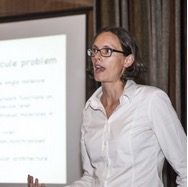Royal Society of NSW News & Events
1230th OGM and public lecture
“Super-resolution microscopy: understanding how T-cells make decisions”
 Scientia Professor Katharina Gaus
Scientia Professor Katharina Gaus
ARC Centre of Excellence in Advanced
Molecular Imaging
Program in Membrane Interface Biology, UNSW
Wednesday 4 March 2015
Union, University and Schools Club, 25 Bent Street, Sydney
Professor Gaus described her ground-breaking work on understanding the structure of T-cells, one of the major components of the immune system. Professor Gaus is a cell biologist who uses super-resolution microscopy to explore the structure of cell membranes. Hopefully, this will lead to improved treatments for infectious, cancer and autoimmune diseases.
The adaptive immune system is the body’s first line of defence against infection. It is acquired over the life of the organism, developing a ‘memory’ for antigens (antigens are the invading agent). This highly sophisticated system is antigen-specific and must be able to distinguish between foreign antigens and substances made by the host. It is mediated by T-lymphocytes – a type of white blood cell that plays a central role in cell-mediated immunity. T-lymphocytes are characterised by the presence of a T-cell receptor (TCR) on the cell-surface. Antigens bind to T-cells through major histocompatibility complex (MHC), a set of cell-surface molecules that controls a major part of the immune system in all vertebrates. Humans can make up to 25,000,000 different TCRs, representing an enormous variety of substances against which the body can mount an immune response.
The role of T-cells is to hunt for antigens. Over the last 50 years or so, the way in which T-cells identify antigens has been characterised: TCRs can only recognise peptides on MHC, T-cells do not recognise self-peptides on self-MHC, and T-cells that react to self-peptides on self-MHC result in autoimmunity. T-cells are responsible for life-and-death decisions – they have to distinguish between self-peptides and foreign peptides. This is like looking for a needle in a haystack; there are many more self-peptides and foreign peptides. Gaining a better understanding of the structure and function of T-cells is important in developing treatments for autoimmune diseases and cancer. For example, it is known that T-cells play a role in the body's resistance to various types of cancer. However, one of the problems in cancer immunotherapy is to determine why some cancers escape T-cells and whether or not they can be retrained.
Professor Gaus’s work is focused on using microscopy to identify the structure of T-cell membranes. There are two major problems that need to be solved to investigate this. T-cells are very mobile – they move rapidly through the blood and it is difficult to capture images of them. Fortunately, once they bind to an antigen, they become almost stationary. The second problem is one of resolution. The molecules being investigated are 10–20 nm in size. The diffraction limit for a visible light microscope is about 250 nm which means that they cannot resolve these molecules. This requires super-resolution fluorescence microscopy, form of light microscopy that allows capture of images that at a much higher resolution than the diffraction limit. Super-resolution fluorescence microscopy enables investigation down to the to the size range of the T-cell molecules of interest.
By acquiring very large samples of data (20,000 frames), x-y coordinates can be determined and statistical methods can be used to analyse structure of specific molecules. Professor Gaus’s research has identified a number of interesting observations about the function of T-cells. It seems that only some T-cells trigger on exposure to an antigen and receptors seem to be triggered in dense clusters. TCR clustering appears to a key element in antigen recognition and some antigens appear to induce TCR clustering. This raises interesting questions such as, can we use nanoparticles to induce clustering?
Recently, Professor Gaus has been investigating ways in which the z-axis can be explored so that molecules can be investigated in all three spatial dimensions as her earlier work suggests that the dynamics of the molecules (such as oscillating like a yo-yo) may be important in their function.
Sydney meetings
- Sydney meetings 2024
- Sydney meetings 2023
- Sydney meetings 2022
- Sydney meetings 2021
- Sydney meetings 2020
- Sydney meetings 2019
- Sydney meetings 2018
- Sydney meetings 2017
- Sydney meetings 2016
- Sydney meetings 2015
- Sydney meetings 2014
- Sydney meetings 2013
- Sydney meetings 2012
- Sydney meetings 2011
- Sydney meetings 2010
- Sydney meetings 2009
- Sydney meetings 2008
- Sydney meetings 2007
- Sydney meetings 2006
- Sydney meetings 2005
Hunter meetings
- Hunter meetings 2023
- Hunter meetings 2022
- Hunter meetings 2021
- Hunter meetings 2020
- Hunter meetings 2019
Southern Highlands meetings
- Southern Highlands meetings 2023
- Southern Highlands meetings 2022
- Southern Highlands meetings 2021
- Southern Highlands meetings 2020
Details of events scheduled for the remainder of the current year by the Southern Highlands branch can be found on its website, while details of events of previous years can be found here.

